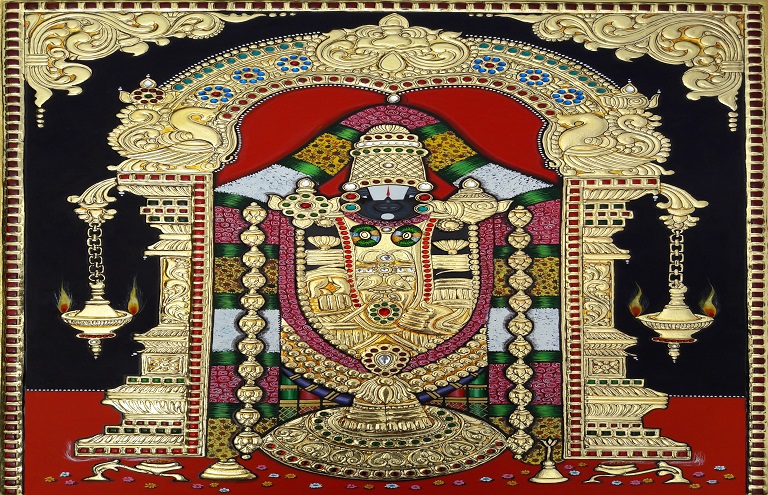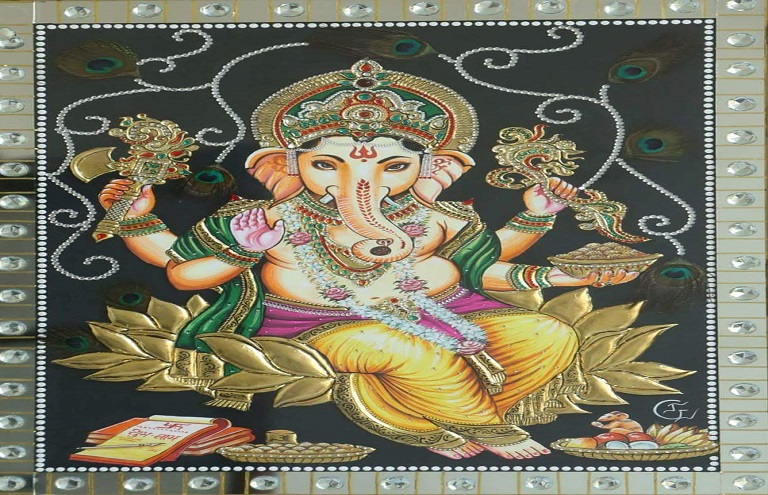
What is Tanjore Painting?
A traditional Tanjore Art rose from the roots of Southern India. Also called Thanjavur Painting, it is created as a celebration of the rich and artistic traditions and cultures of the region Thanjavur in Tamil Nadu. Being known for its extravagant depictions of gods and goddesses with the help of vibrant and dark colors. They are also known to use gaudy embellishments like gold foil.
While the art form of Tanjore has gone through a vast change since its birth, it continues to be one of the popular kinds of art in the Tanjore paintings gallery today. The professionals and artists are also fascinated and thus are known to love the Tanjore Art truly.
https://indianartideas.in/artwork/balaji/14595
Ancient Roots and Patronage:
Being one of the successfully growing art forms, Tanjore Paintings have drawn great inspirations since the 16th century under the administration of Vijayanagara Rayas and his kingdom in Southern India. This was all done under the supervision of the Nayaka Governors- the great patrons who supported art and literature.
Under the establishment of Maratha Rule in 1676 in the region, they too encouraged the flourishment of Art and Artists. This is the time when Tanjore’s painting developed and grew as the style it is known for today. As the palaces and buildings were made, they were seen decorated with beautifully made paintings of deities, rulers, nobility, and courtiers.
The most common element in all the Tanjore Paintings is that the deities are depicted to have almond-shaped eyes with round faces and a streamlined body. Commonly, flat colors are used to paint the same- compactly placed with drapes, ornate, and arches. The composition of density was the known feature of Tanjore Paintings with shaded faces to add a little depth.
Tanjore Paintings Cost:
Tanjore paintings are characterized by well-rounded, pristine-looking deities painted in vivid colors. The ornaments, arches, and sometimes even the deities are adorned in luxurious gold foil, inlaid with glass beads, and sometimes precious and semi-precious gems.
While some of its paintings are sold under Rs. 50,000- the various kinds available are Ganesha Tanjore painting and Lakshmi Tanjore painting. If you have a pocket to buy and an eye for perfection and detailed work- the cost of a Tanjore Painting goes up to Rs.5,00,000 too.
The harmony between classic deep-toned colors and the jewel stones dipping into the lush gold foil stages a grand ambiance in the artworks. Apart from the gold leaf technique, Tanjore paintings are also famous for their unique gesso work. Gesso’s work is masterfully done to elevate the main characters and bordering arches from the surface, which gives a captivating three-dimensional depth to some Tanjore paintings.
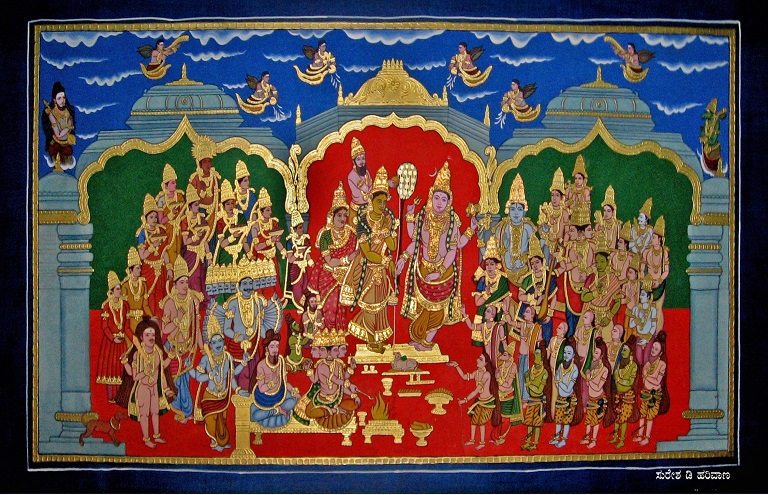
https://indianartideas.in/artwork/girijakallyana/13411
How to Identify the Originality of Tanjore Paintings?
People have since a long time ago realized that only one out of every odd Thanjavur painting that sparkles is gold. There was, nonetheless, no real way to see whether the gold foil and gemstones utilized in these customary artworks were true or phony — not without destroying the artistic creation.
The gold foil utilized generously in Thanjavur works of art fills twin needs — it adds sparkle to the artwork and makes it more appealing and ensures and delays the existence of the artistic creations. Foils made of phony material look practically like real gold along these lines making it hard for buyers to know the distinction.
Of the 10 gold foils tried, just three were observed to be certifiable. On account of canvases, just a couple out of 10 ended up being certified gold foil. The gold foils and artworks (for the most part made as of late) utilized for the investigation were acquired from craftsmen from in and around Thanjavur. Right now, there is no administrative system set up to check the nature of gold utilized in Thanjavur compositions despite circularly rub the wet cotton the way that Thanjavur works of art have Geographical Indication (GI) labels, which puts a premium on their credibility.
By utilizing Raman spectroscopy, Ramanathan Venkatnarayan from the Department of Chemistry at Indian Institute of Technology (BHU) Varanasi and his group of analysts from SASTRA University, Thanjavur, Tamil Nadu have tracked down a simple method to distinguish if the foil utilized in the canvases is made of gold or other less expensive material.
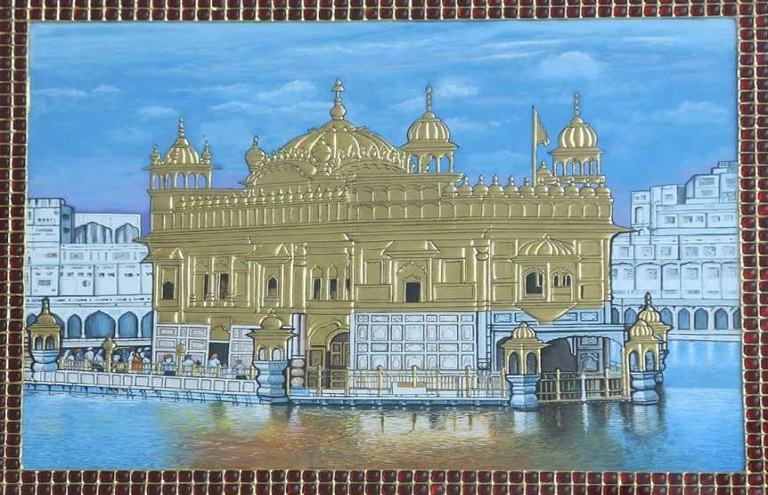
https://indianartideas.in/artwork/golden-temple/9363
How to Make a Ganesha Tanjore Painting?
Tanjore Painting is a type of ancient art form- learning them in some easy steps would b difficult. But still, as we say, practice makes a man perfect! So, let’s start with some amazing and basic steps:
Be ready with the following materials:
- Plywood- 6mm
- Cotton cloth- white
- Chalk power
- Sandpaper
- Flat brush
- Jaipur Stones- Colored
- Arabic Gum
- Gold Foil
- Poster colors
- Pen-Balck
- Rounded Brush
- Transparent Ink- Multicoloured
- Yellow carbon
- Pencil
- Cutter
- Ruler
- Reference art or drawing or sketch
A Step Closer To Your Ganesha Tanjore Painting:
Step 1: Preparing your very canvas
Soften the edges of the plywood with the help of sandpaper. Use a clean cotton cloth (thicker than 1 inch on all the sides) and paste it on the plywood with a paste made out of water and Fevicol. Keep the ratio for the same to be 4:1.
Channel the glue by espresso channel and Immerse cotton fabric in it for few minutes. Now Lift wet cotton material from the principal glue, wash the material tenderly. Hold it for some time so that additional glue gets drained. Now spread wet fabric on top of the compressed wood and wipe the material delicately from focus to edge on a level plane and crease additional material to the opposite side. Pull the collapsed additional fabric for the wrinkle-free surface in the front side and glue the rear material unequivocally with Fevicol only.
Keep the wet material to dry on the paper for a few hours. Let’s set up the second glue for layering the material for this Make a glue of proportion Chalk powder: Water: Fevicol – 2: 1: 1. Take a clean wide-level brush (favored size is 2-3 inch brush) Apply the second glue on the material evenly and pass on it for 10-15 minutes to dry. Then, at that point go for applying upward. Rehash something very similar until the finish of the layering glue. Pass on it to dry in conceal for one day. Now take a piece of emery paper, and overlay that as a more extended stripe.
Step 2: Tracing the design
Once you decide on the Ganesh painting, trace put the same on the canvas with the help of a yellow carbon paper. Just outline the image without giving much importance to the minute details such as that of the ornaments. Such a trace will help you make the judgment of the space. You must ensure a little extra care by providing a margin on all four sides of the canvas. This will help to accommodate a frame without hiding your painting.
Step 3: Sculptural Time
With the help of a flat brush, or you can also use a flat one, start applying a layer of embossing gum on the decorative areas. It should be spread in the following ratio- 1:2:1- Arabic Gum: Chalk Powder: Fevicol.
You can repeat the process to add more embossment to certain areas. Post this, mark the places where you wish to paste stones and pearls with the help of a pencil or a pen. Once the same is done, start locating the pearls or stones with a mixture of water and Fevicol. Let it dry well for a day.
Step 4: Decoration Time
For a smooth and effective glitter look, apply a layer of embossing gum over the stones and pearls pasted in the previous step. Give it an hour to settle down. Post this, take a bowl of water and cotton- and squeeze the cotton to remove the extra water. Gently rub the wet cotton in a circular manner on the area embossed. Try and maintain the neatness of the painting area.
Step 5: Improvisation
Imprint the plan with the assistance of a Ball-point pen over-decorated area. In a cone fill a blend which contains Arabic Gum: Chalk powder: Fevicol in the proportion of – 2:2:1/2. Cautiously accomplish cone work in filling region (like side corner/column) with the great conventional plan. Additionally, offer limits to the stones and pearls with the assistance of the cone. Furthermore, let it dry.
Presently cut a gold foil sheet from the Gold foil booklet. Spot the gold foil sheet over the plan and imprint an edge impression with your thumb for a rough shape. Cut the required state of gold foil by passing on 3 to 4 mm extra on every one of the extents of the required shape. Apply stick (Fevicol with water combination) to the posterior of the gold foil and spot over the plan area. Remove gold foil glued over stones in Thanjavur painting. For this Groove the shape with Safety-pin tenderly. Simply apply the wet brush to the focal point of the stone.
Use a self-clasping pin to eliminate the mellow wet gold foil. You can utilize johnson buds rather than a brush. The state of the stone can be changed utilizing self-clasping pin itself.
Step 6: The Final Countdown
Presently paint the figures and foundation cautiously with banner tones. The artistic creation is ordinarily done utilizing a white tone for the critical figure and marginally concealing it with blue or the typical body tone. The portrayal is typically static and the canvas doesn't mirror any activity or development. The utilization of the foundation tones is generally striking – it is a dull shade of red, blue, or green. The compositions are portrayed by columns and blinds in the side, and some more modest compartmentalization at the base or top to oblige little figures.
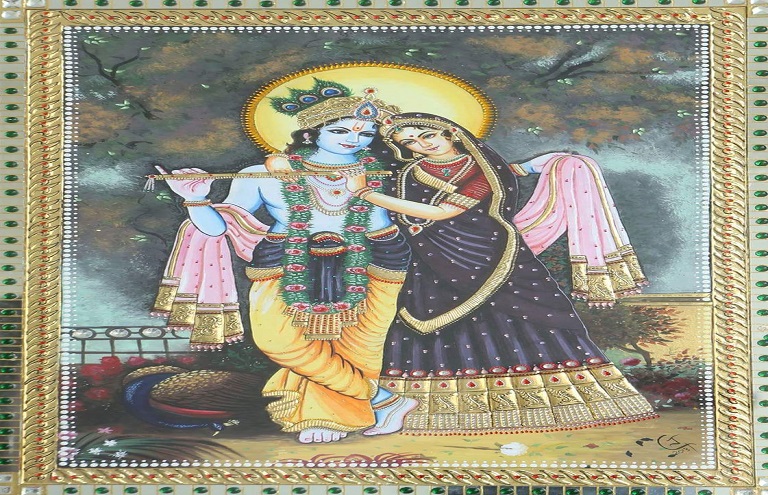
https://indianartideas.in/artwork/radha-krishna/9364
Best Tanjore Paintings:
Tanjore Paintings and art styles have marked the establishment of great traditions and cultures that we hold in India. While we grow towards the modern era- keeping in touch with our roots is a must. After we have read a lot about the residing knowledge about Tanjore art, making sure that you are well-versed with some of the amazing works is important too.
1.Raja Alangara Ganesha yellow Tanjore Painting
2.Annapoorani Red Tanjore Painting
3.Balaji Blue Tanjore Painting
4.Gajalakshmi Red South Tanjore Painting
5.Saraswathi White & green Tanjore Painting
6.Gaja Lakshmi Antique finish Semi Embossed Tanjore Painting
Thanjavur Paintings are still made, with the same enthusiasm and love for one’s own tradition and culture. While it brings happiness, the brazing commercialization and decreasing aesthetics are interrupting the whole process. Many artists have taken the knowledge and art to next level by collaborating it with modern-day art and media. Nowadays, Tanjore paintings are done with mirrors, canvas, and glass.
Read More: A Comprehensive Guide to Finding the Right Frame for your Tanjore Painting
Wrap Up:
While wrapping up the blog here, one can proudly address oneself as someone well-versed with the idea of Traditional Ganesha Tanjore Paintings and Lakshmi Tanjore painting. With the onset of growing demand for such ancient and traditional paintings, people try and get aware of a lot of things that they did not know about. Post-reading this blog, you would be able to answer and argue with a better knowledge that we help you inculcate on.
While making sure that you get all in one information with us, you can also get some amazingly prepared Tanjore Paintings- at Indian Art Ideas- one of the top-rated Tanjore Painting Gallery! Grasp in the growing demand for such paintings and let the traditional roots of your country hold a space in your house. Hold on to the best in the market and let your house light up.





















